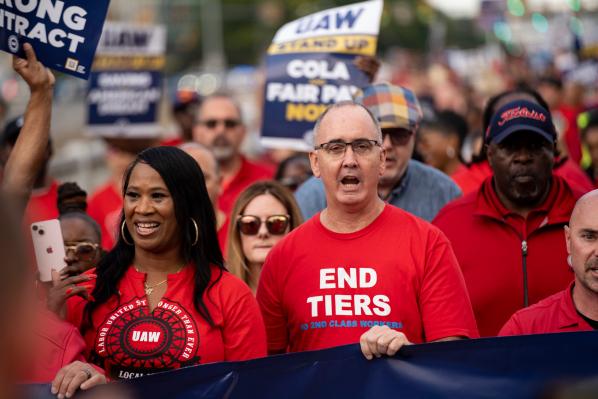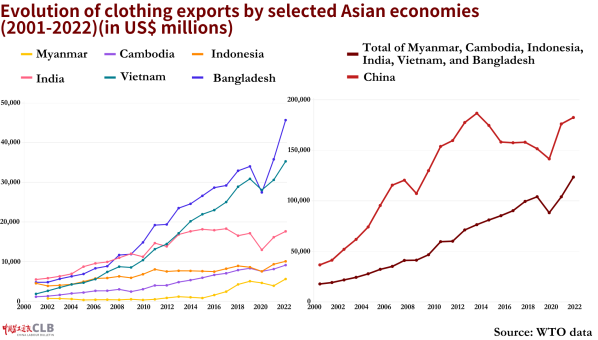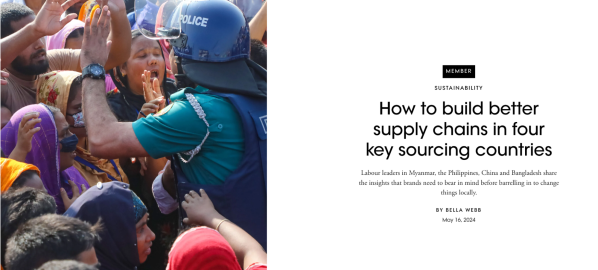
UAW president leading a march in the 2023 strike and collective bargaining. Photo Credit: Luis Yanez/shutterstock
Letter from the Editors
This May on Labour Day, activists and researchers in Brazil, Chile, China, Italy, Türkiye, and the United States brought together their data on strikes in 2022 to publish the International Strike Report (2022). The report can be read here.
CLB contributed to the China section. The report aims to provide a better understanding of workers’ strikes throughout the world and document innovative efforts of activists and researchers to overcome limitations in official data sources. It focuses on strikes in 2022, rather than 2023, due to the labour-intensive nature of collecting and analysing strike data. We hope that future reports will be closer to the calendar year.
Thanks for reading!
CLB Editors
CLB insights

The global apparel industry’s contraction has led to widespread protests in China and Southeast Asia. CLB recently researched apparel workers' collective efforts to defend their rights during the 2023 market downturn. We found that factory relocations within the region often led to labour rights violations and a variety of reactions based on local contexts.
Global fashion brands have been outsourcing their production facilities and rewiring their supply chains for decades. To respond to the new market conditions and stay profitable, companies have shifted their supply chains out of China in search of even cheaper labour. Bangladesh and Vietnam are the two countries that have received the most capital. Cambodia and Myanmar’s export growth rates have also greatly increased, with the latter growing by more than 700 percent since 2019. China remains the world’s top clothing exporter, but its share of global apparel export value has decreased from 37 percent to 32 percent between 2010 and 2022.
The geographical expansion of the garment industry in the past decade means that when international brands decided to cut orders to stay profitable in 2023, the ripple effect impacted many more countries and workers in both China and Southeast Asia.
Workers’ Representation

Throughout 2023, the Strike Map logged 94 incidents of garment workers’ collective actions in China, a huge spike compared to only six cases in 2022. Strikes and protests were concentrated in the factories that produced finished products, such as clothing (30 incidents) and footwear (25 incidents). Workers protested against wage arrears and unpaid social insurance, and demanded layoff compensation when factories announced closure. In all these protests logged, international brands were not seen getting involved in the negotiations between factories and workers. In situations where there were negotiations, as in the cases of Jiaxing Quang Viet Garment Company and Yangzhou Baoyi Shoe Factory, only management of the supplier factories and the local officials are present.
The protest in Bangladesh shows that even though unions and workers were adamant about raising minimum wage, owners of supplier factories were resistant to a pay rise and blamed the purchasing patterns of international brands for low wages. Although this push and pull is between workers and factories, the impact of regional supplier and brand decisions is felt by both groups. Besides, the reduction of orders and price cuts from international brands have led to various small-scale protests in various Southeast Asian countries.
In Indonesia, the effects of garment unions’ negotiations with factories are largely limited by international brands. The garment union Serikat Pekerja Nasional (SPN) shared with CLB that factories were pushing back on their wage increase demands, claiming that the brands’ order prices were too low.
CLB’s study of how worker organising and union representation varies in the region shows that workers and unions need to utilise new due diligence legislation and tools to coordinate and fight against a global challenge. International garment brands should be involved in monitoring suppliers' labour practices across vast production networks.
Workers’ Voices

Photo credit: helloabc/shutterstock.
“Our family lives, economic situations and future plans are severely affected…Our hard work should be fairly paid. This is our right. Yet we are abandoned in a bitter situation, feeling disappointed and angry.”
In June 2023, two thousand workers of Aiways wrote an open letter to the company’s management and shareholders demanding overdue wages and social insurance payments. Workers had not received wages for three months, but no one responded to their concerns and requests. Their phones and messages were ignored, and they were ordered to work from home indefinitely instead of being properly laid off and compensated.
Aiways is just one of the lower-tier EV companies in China that were especially hard hit in the year 2023, when the EV consumer subsidy program by the central government ended, and Tesla lowered the price of popular models and started the price war among auto OEMs in China. Of the major EV companies in China, only Tesla and BYD had crossed the break-even point and made profits. They are considered top or first-tier, closely followed by second-tier companies that sold more than 100 thousand EVs per year in 2022-2023 (such as Aion, Li Auto, NIO, Xiaopeng and Leapmotor). The rest are lower-tier companies, many halted production with overdue wages, social insurance payments and severance pay in 2023.
Workers and trade unions in China have to be prepared for both the transition to EV jobs among various companies and the absolute reduction of auto manufacturing jobs. Workers could face layoffs in ICE and EV companies, with problems of overdue payments, inadequate compensation, reduced wages and overtime, relocations and loss of quality and formal employment. While the EV transition is important in tackling climate change, worker employment and labour rights have to be protected for a just transition. The official trade unions in China have yet to address these problems and make long-term plans.
CLB recommended that the experiences of German and U.S. auto workers and unions can serve as reference/examples, in the last portion of this article we wrote briefly how local unions led collective bargaining and signed collective agreements for workers.
Strike Action
Taxi drivers went on strike to prevent the introduction of shared electric bikes into the market in Longshan, Hunan. Around 100 taxi drivers in Longshan County, Hunan Province, went on strike on 28 April to protest against shared electric bikes being introduced to the market. Videos posted by the drivers show taxis lined up along both sides of the road for about a kilometer. Following the strike, the company, Hunan Longfeng Longxiang Taxi Co., Ltd., issued a notice stating it would withdraw all the vehicles. However, the company also demanded that all drivers leave the strike location or else face revocation of the lease agreements. In August 2020, China Labour Bulletin reported on taxi drivers across the country protesting the introduction of electric bikes. The strike this month is a continuation of the taxi drivers’ resistance to increasing competition.
Workers’ Requests for Help
A Hangzhou courier of the ZTO Express sought help from the media after being excessively fined. According to the courier, within three months of his employment, he has received a total of 99 penalties amounting to 4,305 yuan. The heaviest one was imposed for failing to identify prohibited items while taking an order, resulting in a fine of 2,000 yuan. Another fine of 500 yuan was the result of losing a package. The courier complained that the package had actually been collected by a friend of the recipient, but the fine still needed to be paid due to the customer complaint. The high fines in the courier industry in China have continued to fuel grievances among workers. The new regulation of "mandatory doorstep delivery" implemented by the Ministry of Transport in March has previously triggered couriers’ collective actions.
Tech companies are not the only ones abusing non-compete agreements in China. Employees of Shanghai real estate agency Pacific Realtor sought help from the media, claiming that they have been required to pay damages of up to 500,000 yuan for violating non-compete agreements after leaving the company. The employees stated that around forty to fifty workers have been asked to pay the damages, and the company's claims have received support from the courts. Employees were usually not fully aware of the agreement's contents and consequences when signing the contract. Faced with the threat of high damages, some workers of Pacific Realtor have no choice but to return to work for the company. CLB has reported on Pinduoduo’s aggressive enforcement of non-compete agreements. While only senior management and senior technical personnel should be subjected to non-compete obligations, the law has been exploited to target low and mid level employees in many companies.
CLB in the news

Director of China Labour Bulletin, Han Dongfang, was interviewed by Vogue in an article that discusses how to build better supply chains in Myanmar, the Philippines, China and Bangladesh. Dongfang gave his opinions on the core problem he saw in the garment industry in China, “Workers in China have no bargaining power, no representation … When bargaining power is ignored, and factories are scared to lose orders, they squeeze workers as low as possible.”
Dongfang explained that the problem is not Chinese labour law, but getting suppliers to abide by that law. Workers also need to have a means to report and rectify violations of it. International brands need to commit to their due diligence practice. They also need to take up responsibility as their order price limits the wage increase level of garment workers in China, “You can’t make the factory owners pay workers more if brands aren’t willing to pay more — factories are not charities.”
